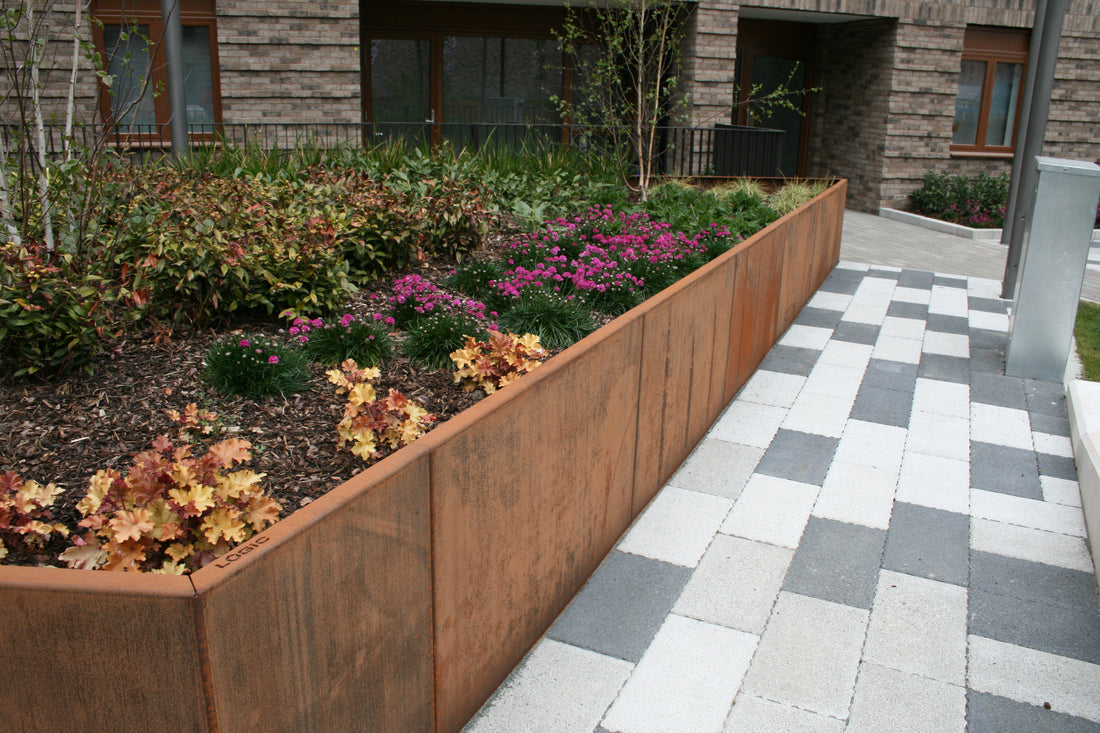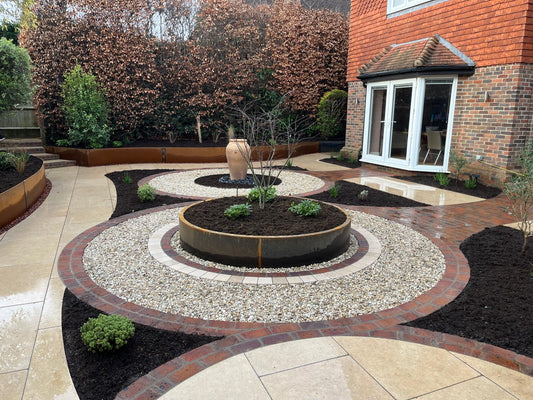
Do metal planters rust?: Are Powder-coated planters right for me?
Do Metal Garden Planters Rust? Everything you need to know about Powder-coated planters.
Metal garden planters offer a sleek, modern look and durability that many gardeners appreciate. However, it's critical you consider the effects of rust. Rust susceptibility varies significantly depending on the type of metal used and how well you maintain the planter. In this blog, we'll explore the rust characteristics of different metals, common issues leading to rust, and how you can ensure a rust-free planter for the next 20 years.
Understanding Different Metals Used for Garden Planters
Corten Steel
Corten Steel is a unique type of metal because it's designed with a special alloy that encourages rusting. Unlike other metals that corrode and deteriorate, Corten Steel develops a stable, protective rust layer that prevents further corrosion. This intentional rusting gives Corten its distinctive weathered look, often sought after for its aesthetic appeal.
Characteristics: The rust layer formed on Corten Steel acts as a barrier against the elements, making the metal more resistant to further corrosion. This protective layer, once fully developed, can actually help extend the lifespan of the planter.
Maintenance: Corten Steel planters require minimal maintenance. However, it’s essential to place them in well-drained areas to prevent excess moisture from impacting their appearance and durability.
Stainless Steel
Stainless steel resists rust and corrosion exceptionally well, making it a preferred choice for planters in harsh environments, including marine settings. The key to its rust resistance is the high chromium content, which forms a thin, protective oxide layer on the surface.
Characteristics: Stainless Steel planters are durable, non-reactive, and maintain their appearance even in challenging conditions. They are less likely to rust compared to other metals and are easy to clean.
Maintenance: Stainless Steel planters require minimal upkeep. Regular cleaning with mild detergent can help maintain their shiny, rust-free appearance.
Powder-coated Aluminium
Aluminium planters are typically used as a base material for powder-coated or painted planters and are popular for their rust resistance and low maintenance. As a non-ferrous metal, aluminium doesn’t rust. However, it is weaker and more ductile, making it less suitable for taller retaining wall systems and prone to dents.
Characteristics: Aluminium forms a protective oxide layer that shields against corrosion, maintaining durability and appearance even in harsh conditions. Its lightweight nature makes it easy to handle, but you must take care as it dents more easily compared to other materials.
Maintenance: Aluminium planters require minimal upkeep. They don’t need frequent rust treatments. Regular cleaning with a damp cloth keeps them looking good, and any scratches on coated aluminium can be easily touched up.
Galvanized and Powder-Coated Mild Steel
Galvanized Mild Steel is an excellent base material for powder-coated or painted planters, combining regular mild steel with a protective zinc coating to guard against rust. With a 25-year guarantee, it provides substantial rust resistance. At GEO all our powder-coated planter systems are Galvanised mild steel.
Characteristics: The zinc coating offers effective protection against rust, and with the additional powder-coating layer rust is not an issue.
Maintenance: To maintain its rust resistance, it’s crucial to keep the zinc coating intact and address any damage promptly. Any deep scratches can be touched up to avoid localised rusting. Get in touch to arrange a paint touch-up.
Common Causes of Metal Garden Planter Issues
Unprotected Mild Steel
When you use mild steel planters without any protective coating, they become highly susceptible to rust. Exposure to moisture and oxygen will quickly lead to rust formation, causing deterioration and unsightly appearance.
Zinc Primer vs. Galvanization
Sometimes, a zinc primer is used instead of full galvanization. While a zinc primer provides some level of protection, it can scratch revealing the mild steel. Over time, scratches or damage can cause the primer to wear off, exposing the bare steel underneath to rust.
Unrepaired Damage
If scratches or impacts damage a planter with a protective coating, such as galvanisation or paint, and you do not repair it, moisture can reach the metal surface and cause rust. Regular inspections and prompt repairs are essential to prevent metal planters rust from spreading.
Unsuitable paint application
Powder-coating offers superior durability and low maintenance for outdoor use compared to traditional paint. It creates a tough, uniform finish that resists chipping, scratching, and fading, making it ideal for harsh weather conditions. It also has a lower environmental impact due to reduced VOC emissions. In contrast, traditional paints can vary in durability, often requiring more frequent maintenance for issues like peeling and fading. While paints offer a broader range of colours and finishes, they generally lack the robustness of powder coatings and can be less eco-friendly due to higher VOC content.
Powder-Coating: The GEO Solution
At GEO, we use polyester powder-coating applied to galvanised steel. This coating is baked onto the metal, creating a durable, long-lasting finish that comes with a 20-year guarantee.
Characteristics: Powder-coating provides excellent protection against rust, chipping, and fading. It is more resistant to scratches and impacts compared to traditional paint and requires minimal maintenance.
Maintenance: While powder-coating is robust, it is not entirely impervious to damage. Deep scratches or gouges can penetrate the coating and expose the galvanised surface underneath. It’s crucial to touch up any damage promptly to prevent rust formation.
Managing and Preventing Metal Planter Rust
Regular Inspections
Inspect your metal planters regularly for signs of rust, damage, or wear. Catching problems early can prevent rust from spreading and affecting the planter’s durability.
Repairing Damage
Address any scratches, chips, or dents promptly. When damage occurs to a powder-coated planter, you need to seal and touch up the area to prevent rust. For galvanized planters, applying a rust-inhibiting primer or paint can help protect exposed areas.
Conclusion
Metal garden planters offer both aesthetic appeal and durability; their susceptibility to rust varies based on the type of metal and maintenance practices. Designed to rust in a controlled manner, Corten steel provides a unique look while offering natural protection. Stainless Steel resists rust effectively, making it suitable for harsh environments. Galvanized Mild Steel provides good rust resistance but requires some maintenance.
Issues such as bare mild steel usage, inadequate protective coatings, and unaddressed damage can lead to rust. If the paint is not suited for outdoor conditions, painted planters may additionally peel. At GEO, our polyester powder-coating on galvanized steel planters offers a durable, long-lasting solution with minimal maintenance.
By understanding the factors that influence rust formation and implementing proper care techniques, you can ensure that your metal planters remain attractive and functional for years to come.




